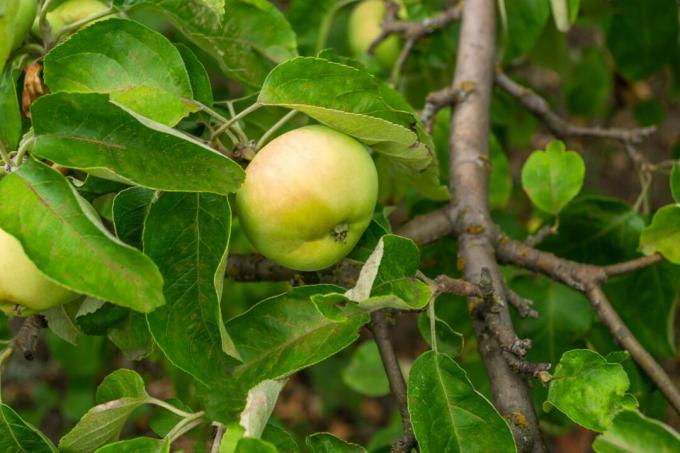The apple variety 'Schöner von Wiltshire' is also known under the name 'White Wax Reinette'. As the name suggests, the apple tree comes from England. In this article you will learn everything you should know about the Wiltshire apple.

If you are looking for an apple that can withstand harsh weather, you cannot ignore the 'beauties of Wiltshire': the apple variety which is also known in Germany under the synonym 'White Wax Reinette' is considered to be extremely robust and easy-care. But does the apple variety also score with its taste? What do you have to consider when growing the 'Schöner von Wiltshire' variety? In our article you will learn everything you need to know about the old apple variety.
contents
- Fairer of Wiltshire: Wanted Poster
- origin and history
- Characteristics and taste of the 'Schoneer von Wiltshire' apple variety
- Growing and caring for the Wiltshire apple: Here's how
- Harvest time and use of the apple variety
Fairer of Wiltshire: Wanted Poster
| synonyms | 'White Wax Reinette', 'Wiltshire Handsome' |
| fruit | medium to large; light yellow color |
| the taste | juicy, sweet and sour, slightly spicy |
| yield | high and regular |
| harvest time | from mid-October |
| maturity | November to December |
| shelf life | medium; can be stored until the end of December |
| growth | initially strong, later medium strong |
| climate | undemanding; frost hardy even at high altitudes; suitable for rough situations |
| diseases and pests | robust against apple scab |
origin and history
As the name suggests, the home of the 'beauty from Wiltshire' is not in Germany, but in England. This is where the apple variety is said to have been cultivated for the first time under the name 'Beauty of Wiltshire' in the county of the same name in south-west England. Around 1800 the 'Lovely of Wiltshire' was raised from seed and later propagated by Mr Standish, who recognized and appreciated the positive qualities of the tree. The first evidence of cultivation of the 'Beauty of Wiltshire' dates from the 1840s. Today the 'Schöner von Wiltshire' variety is most commonly found in southern Germany, especially in Bavaria. Unfortunately, it has become rare overall, which is why it is on the Red List of Endangered Crops.
Characteristics and taste of the 'Schoneer von Wiltshire' apple variety
The fruits of the 'Schoneer von Wiltshire' cultivar are medium to large, conical or flat-topped. The apples are characterized by a waxy, slightly greasy skin and a light yellow color - only rarely does the 'Lovely of Wiltshire' show a finely dotted blush or red stripe on its sunny side. The yellowish-white flesh, which is semi-fine and very juicy, is hidden under the skin. The Schöner von Wiltshire apple is particularly popular because of its taste: its sweet and sour taste with a slight spiciness is what gives the apple its special aroma.
Growing and caring for the Wiltshire apple: Here's how
What is striking when growing the 'Lovely Wiltshire' is its strong growth, which it exhibits in its young years. Over the years, however, this weakened to medium-strong growth. Nevertheless, 'Schöner von Wiltshire' is almost exclusively suitable for cultivation as a standard or half-stem, but never as a trellis or pot fruit. In old age, the 'lovely one from Wiltshire' presents itself with a high-domed, later slightly drooping crown and is considered to be extremely aesthetic. Its medium-early and long-lasting flowering, which proves to be surprisingly weather-resistant, makes the 'Schöner von Wiltshire' variety an eye-catcher in the garden.
Thanks to its persistent flowering, the 'Schöne von Wiltshire' is also considered a good pollen donor for many other apple varieties, such as the 'Gloster' or the 'Weisser Klarapfel'. Numerous apple varieties with medium-early flowering are also suitable as pollinators, for example the ‘Landsberger Renette' or the apple variety 'Berner Rose'. Even at a young age, the White Wax Reinette reliably produces high yields - these also fluctuate with age The old apple variety yields little if it is not thrown off balance by radical pruning.

Both in cultivation and in care, 'Schoner von Wiltshire' is no diva. On the contrary: In fact, this apple variety is particularly suitable for harsher areas, because the variety is very frost hardy. This applies in particular if the apple variety is on its own root, i.e. has not been grafted. In high and cold locations, the 'Lovely of Wiltshire' is therefore still very popular. The blossoms of the 'Schöner von Wiltshire' apple variety are also relatively weather-resistant, so that even moderate late frosts often do not particularly damage the yield. In addition, the 'Beauty of Wiltshire' is extremely resistant to apple scab.
In the youth of the tree, however, sufficient pruning measures must be taken. Due to its strong growth, the Schöner von Wiltshire apple must be pruned properly so that the growth of the tree is steered in the right direction.
Harvest time and use of the apple variety
From mid-October, the pretty apples of the 'Schöner von Wiltshire' variety are finally ready to be picked, and from November to December the apples are finally ripe for consumption. Like most winter apples, the 'Beauty of Wiltshire' stores well. If stored in a dark and cool place with sufficient ventilation, the apple can be kept until the end of December without any problems. The following applies: the earlier the apples are picked, the longer they can be stored. Thanks to its unique aroma, 'Wiltshire Belle' is a good eating apple to savor. In addition, it can also be cultivated as an excellent economic apple for making must.
Would you like to learn more about old apple varieties? In our overview article you will find a large number of traditional apple varieties.



